This gluten-free shortbread recipe makes cookies that are rich and flavorful. They’re not too sweet and the texture is wonderful: slightly crumbly in the best way. The cookies are egg-free and can be made dairy-free.
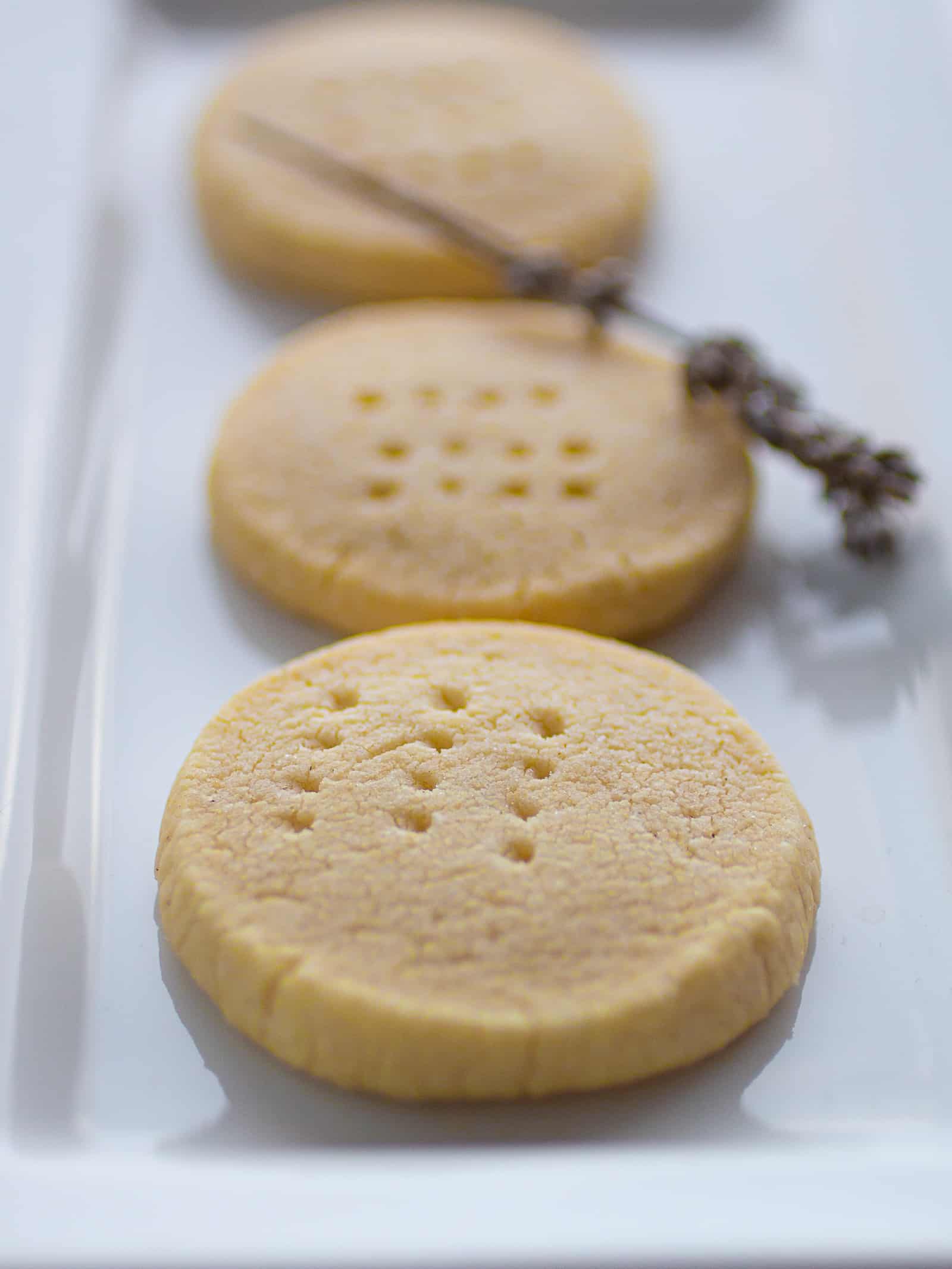
Gluten-free shortbread cookies are rich, buttery, and only require five ingredients to make. Unlike classic gluten-free sugar cookies, shortbread is naturally egg-free. The butter and vanilla are the real stars of the show here. The dough contains just enough gluten-free flour to hold everything together.
Some classic recipes for shortbread contain rice flour. This means the texture of a gluten-free shortbread cookie is very similar to its wheat counterpart. It’s crisp and delicate.
Since the basic recipe is so simple, it welcomes variations. I’ve included a few of my favorites but feel free to play around with this recipe.
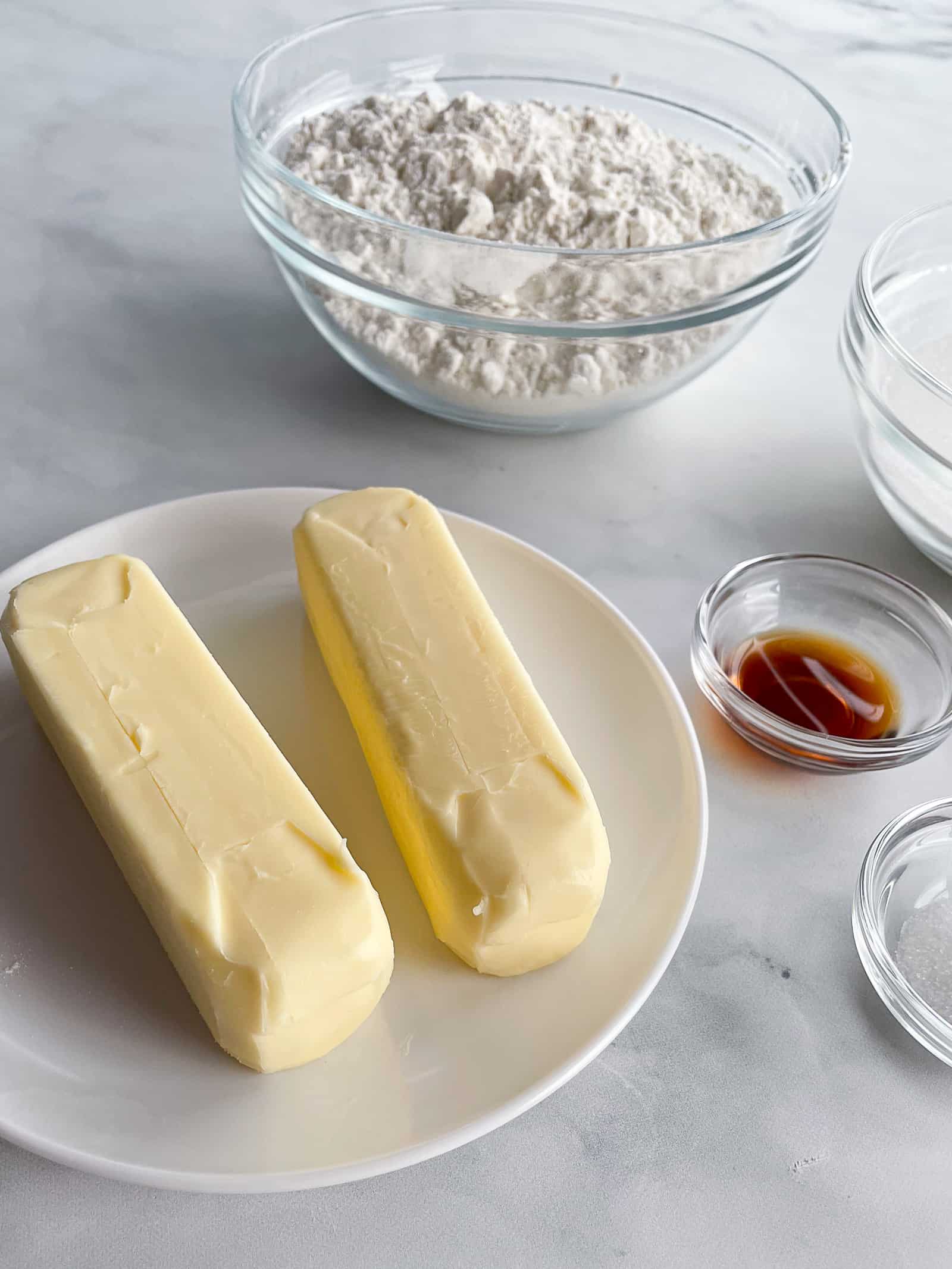
Key Ingredients.
- Gluten-Free Flour. A gluten-free flour blend helps the cookies hold their shape during baking. Look for a blend that contains xanthan or guar gum. (If your blend doesn’t, whisk ¼ teaspoon into the gluten-free flour before using.)
- Butter. Butter is an essential ingredient in shortbread cookies. It gives the cookies flavor and a rich texture. Both salted and unsalted butter work in this recipe but butter is my preference. The salt gives the cookies a deeper flavor and helps to balance the sugar. For gluten-free and dairy-free shortbread cookies, use your favorite dairy-free butter. (See note below for information on gluten-free and dairy-free shortbread cookies.)
- Granulated Sugar. Shortbread’s delicate sweetness comes from granulated sugar. Don’t use maple syrup or honey in this recipe or the cookies will spread.
- Vanilla Extract. A teaspoon of vanilla extract adds flavor.
- Salt. Use fine (table) salt. It blends easily and evenly into the dough. If you only have flaky Kosher salt in the house, increase the salt to 1 ½ teaspoons.
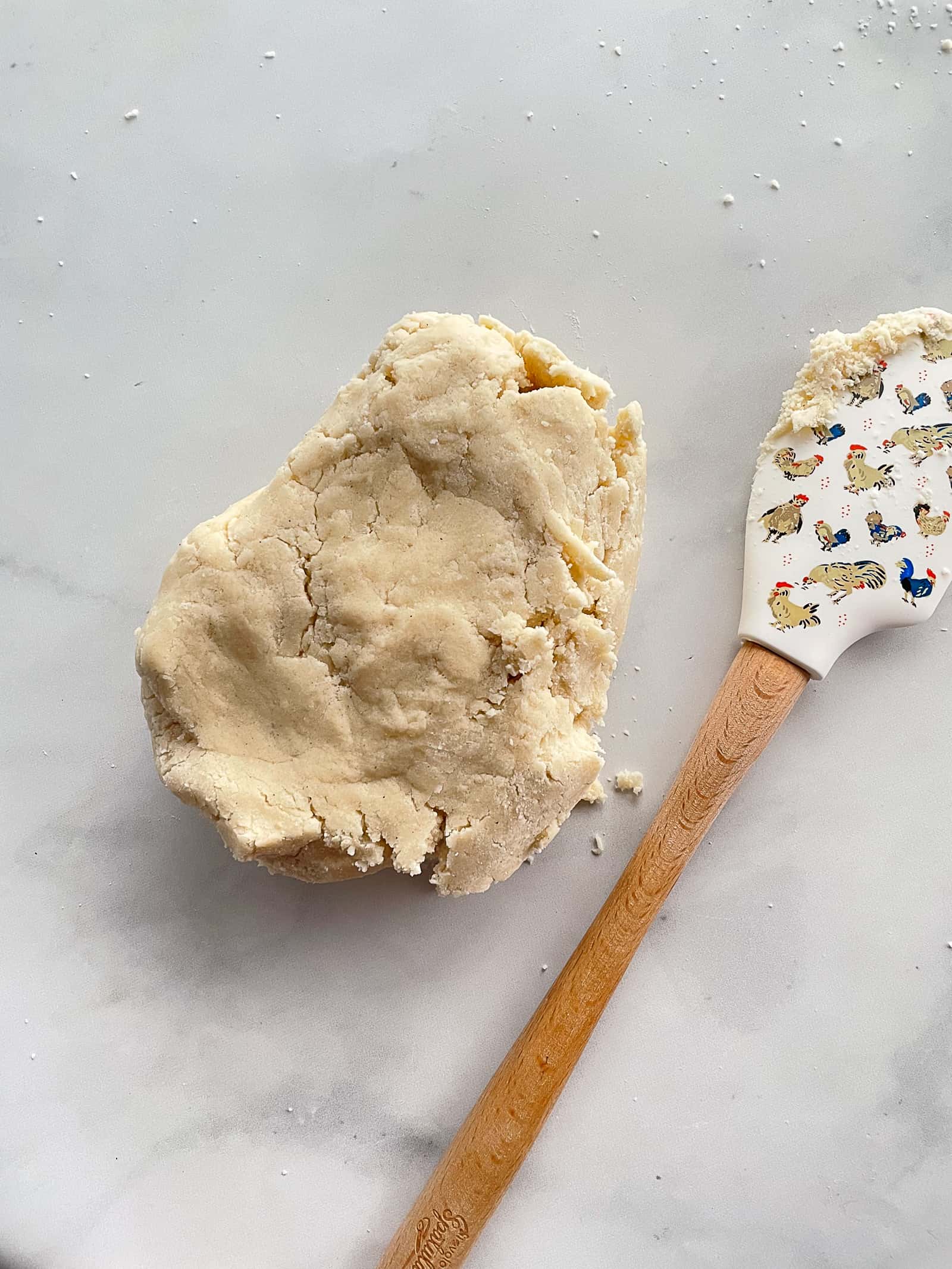
How to Make Gluten-Free Shortbread Dough. Steps for Success.
Gluten-free shortbread is a little tricky to make. Since it lacks liquid, sometimes the dough can be crumbly. Here’s how to make the perfect gluten-free shortbread dough every time.
1. Start with Softened Butter.
The most important step in this recipe is using softened butter. Aim for it to be about 65 to 68℉. You want the butter to feel cool to the touch. If you poke it, look for the butter to give a little resistance but not crack.
If the butter is too cold, the shortbread dough won’t come together. If the butter is too warm, the cookies will spread during baking and turn out greasy.
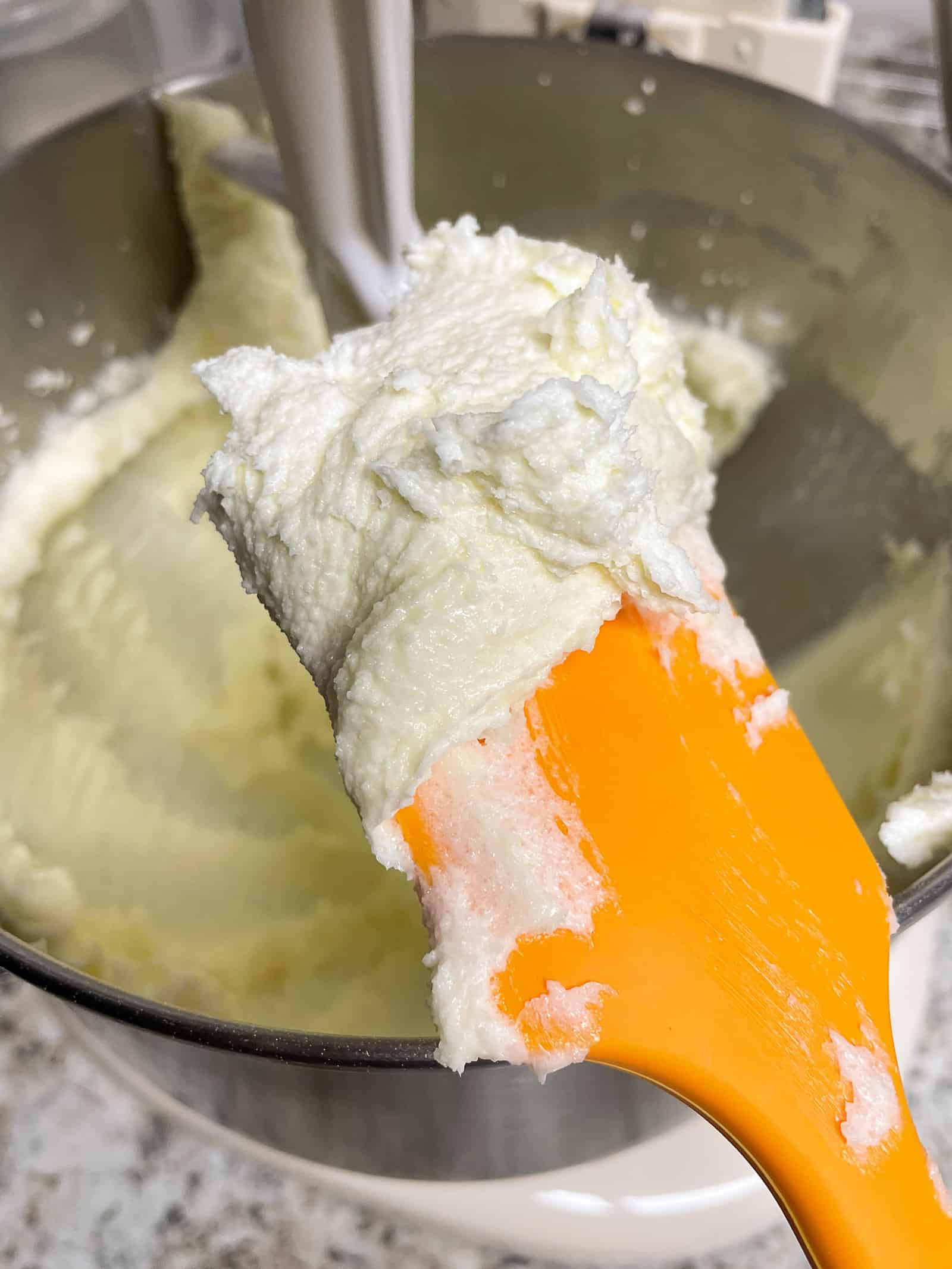
2. Mix the Sugar Until Creamy, Not Fluffy.
The texture of shortbread cookies is one of the things that sets them apart from other butter-based cookies. It’s dense and almost sandy. To achieve this lovely texture, blend the butter with the sugar until it’s thick, not fluffy. If the butter-sugar mixture gets fluffy, like it does for gluten-free pound cake, it traps air. That’s what makes it fluffy. That air causes the cookies to puff and rise, which we don’t want.
Simply mix the room-temperature butter with the sugar and salt until its thick and creamy. This only takes about a minute. It’s a good idea to stop the mixer once and scrape the sides of the bowl. There’s usually a thick layer of butter clinging to the bowl. Mix this in so there aren’t streaks of butter in the finished cookies.
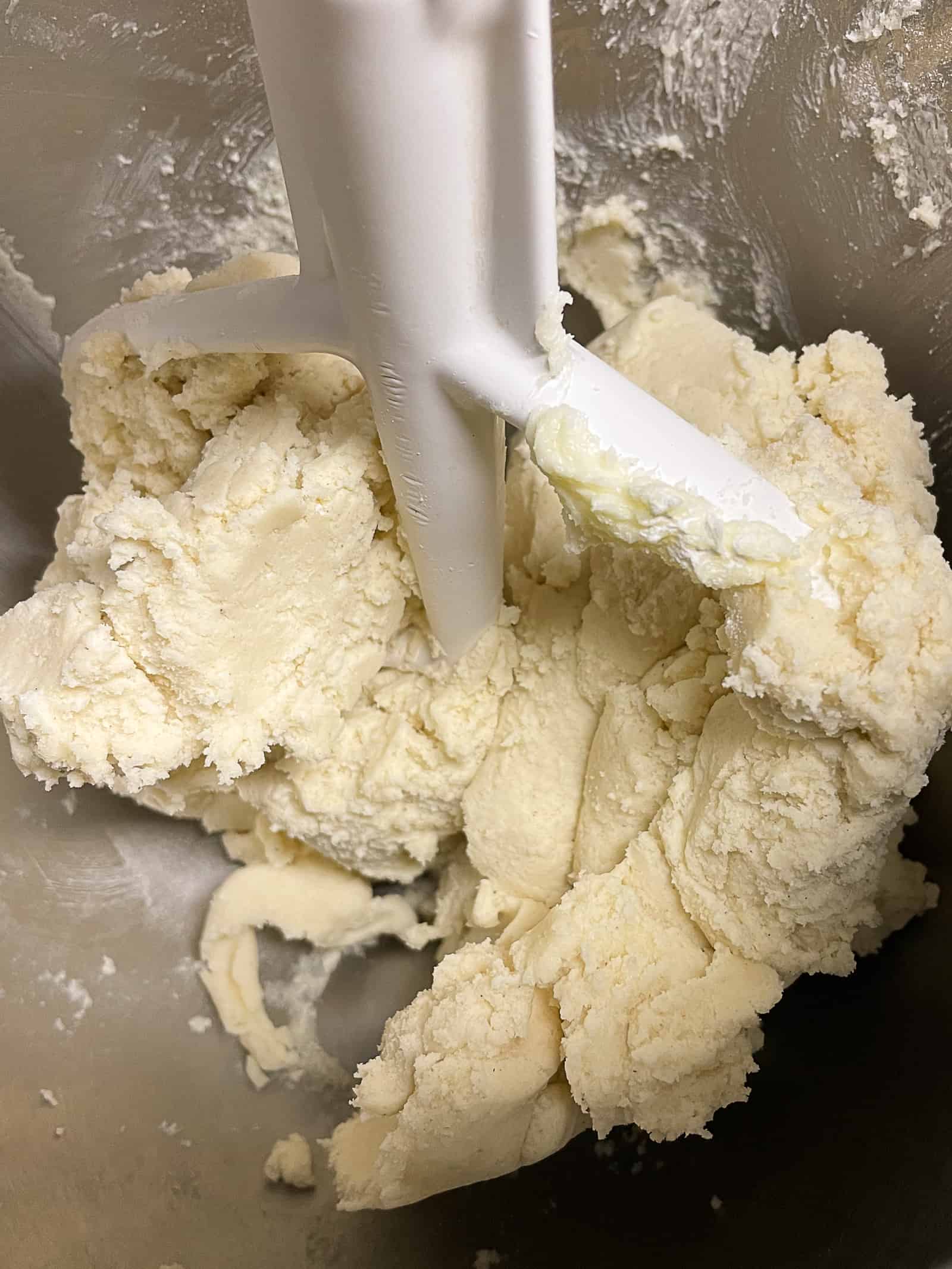
3. Make the Dough.
Since these cookies contain no eggs or liquid ingredients, there’s no moisture to coax the ingredients quickly into a dough. Once the dry ingredients are added to the butter and sugar, it takes a minute or so for a dough to form.
Gluten-free shortbread dough mixed in a stand mixer comes together differently than if mixed with a handheld mixer.
Baker’s Note: How to Make Gluten-Free Shortbread Dough with a Handheld Mixer.
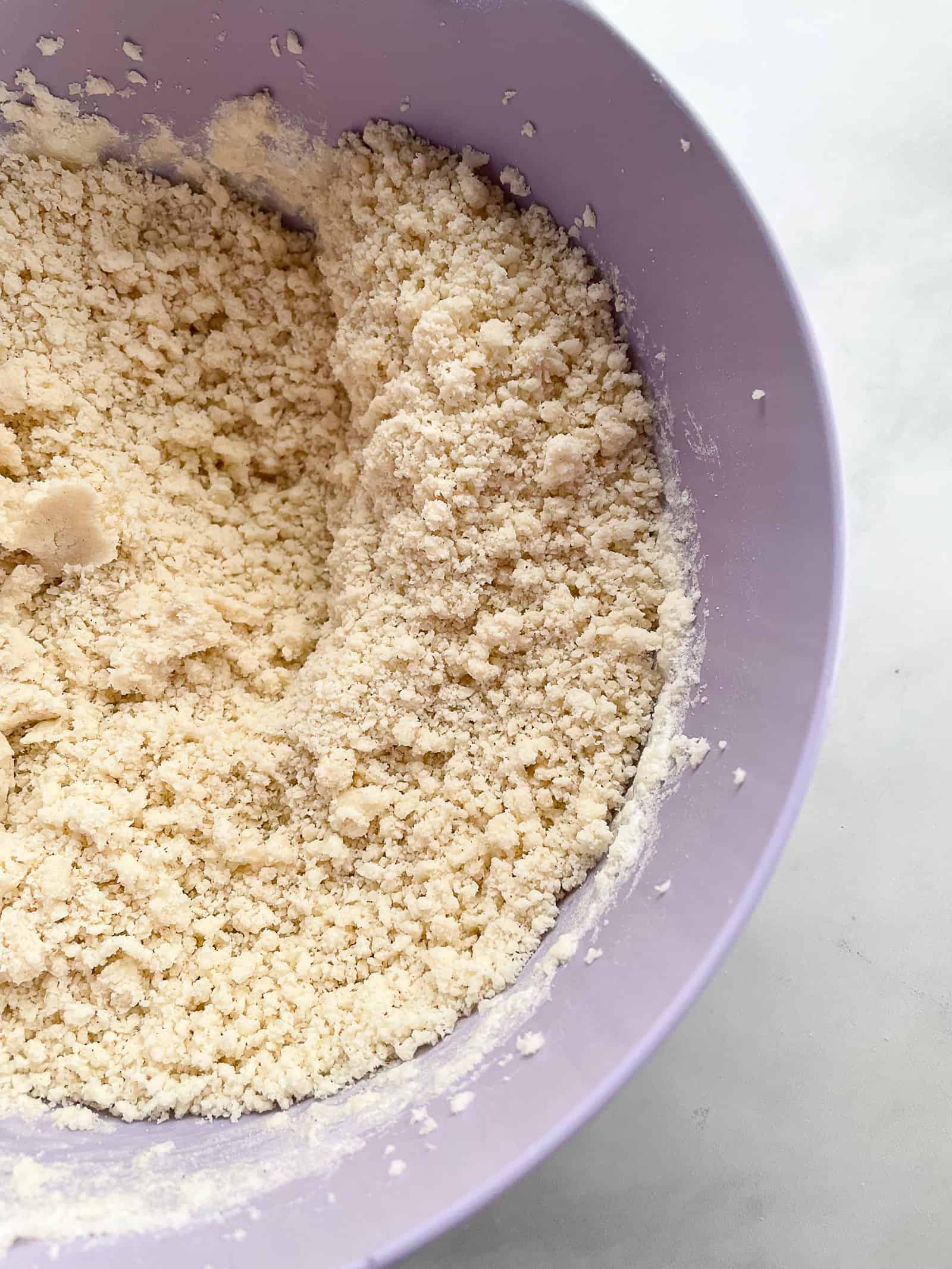
Shortbread dough can look incredibly crumbly and refuse to come together when you use a handheld mixer. This happens because of the shape of the beaters and the power of the mixer. In fact, if you’re using a handheld mixer, you might think there’s something wrong with the recipe at this point.

If you’re using a handheld mixer and you notice the dough is sandy or crumbly, stop the mixer. Give the dough a squeeze. If it easily holds its shape, stop using the mixer. Press the dough into a ball with your hands or a rubber spatula. I do this right in the mixing bowl. You can also turn the dough onto a lightly floured counter and knead it a few times.
If you squeeze the dough and it doesn’t hold its shape, add one teaspoon of water. After you add the water, the dough still might appear crumbly. That’s fine. Give it a squeeze. It should come together.
The exception to this is if the butter is very cold. If the dough is cold, let it warm up and try mixing again.
4. Shape the Dough.
From baking the cookies right in a pan to using your favorite cookie cutter, you’ve got options when it comes to shaping these cookies.
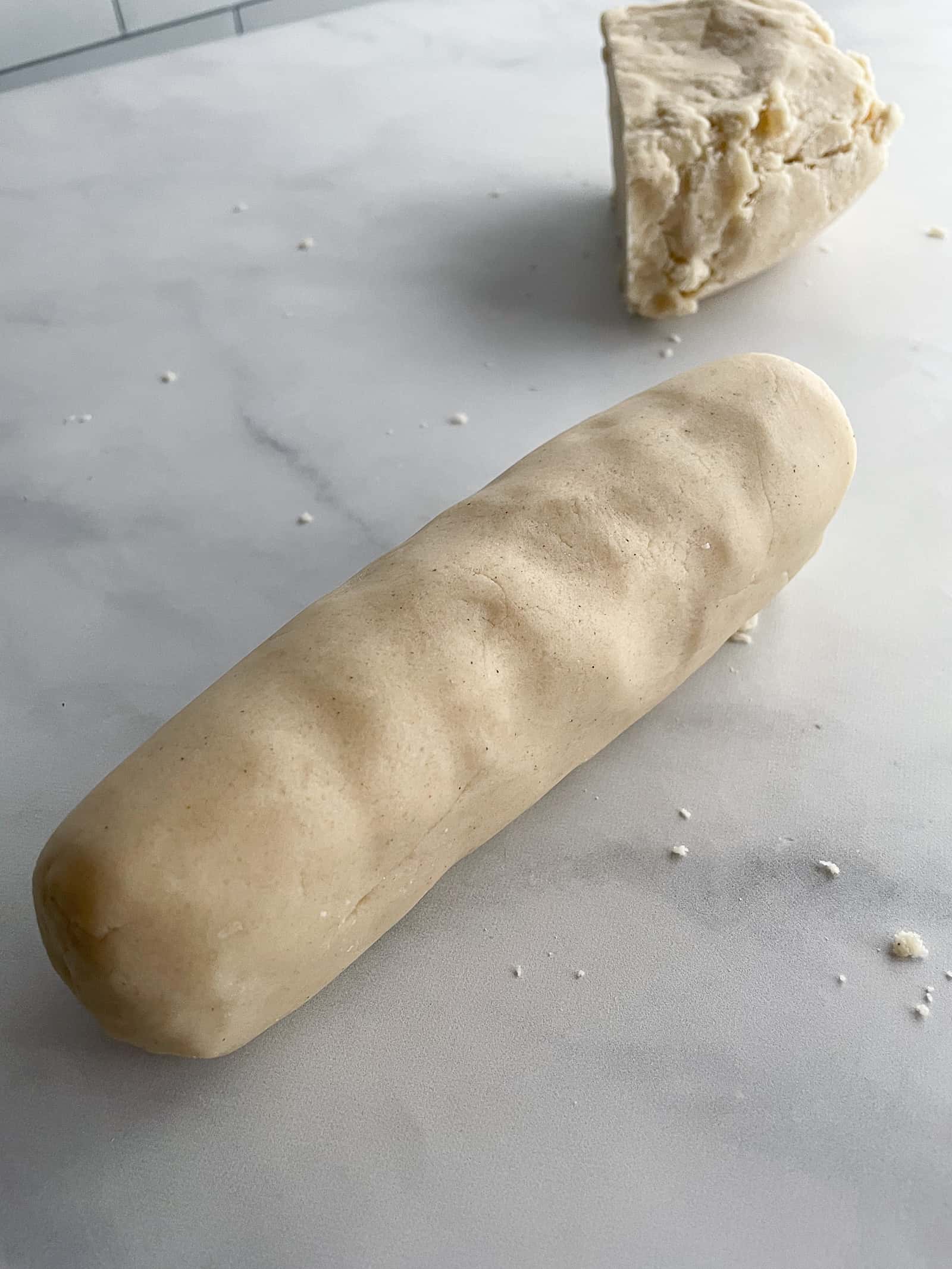
Roll into a log.
To make “slice and bake” shortbread cookies, divide the dough in half. Roll into a log about 2 to 2¼ inches across. Cut into rounds. If the dough crumbs when you cut it, gently press it into a round on the cookie sheet.
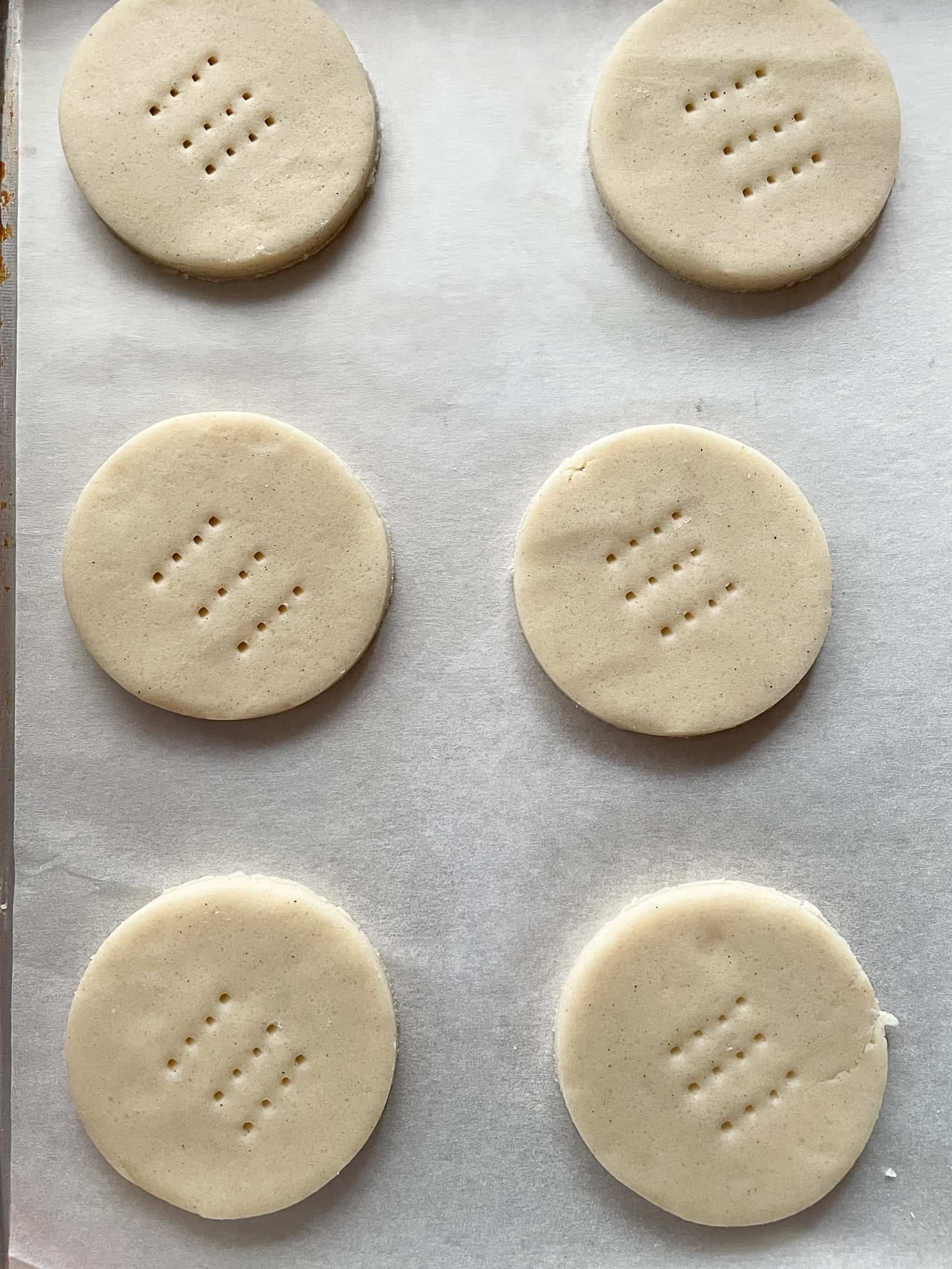
Use a Cookie Cutter.
You can use cookie cutters with this dough. Since it spreads a little during baking, basic shapes, like rounds, rectangles, and stars work best. To use a cookie cutter, dust your counter with gluten-free flour. Roll the dough out to about 1/4-inch thick. Dip your cutter in gluten-free flour and cut.
After cutting out the shapes, gather the remaining dough and re-roll. Since these cookies are gluten-free, they won’t get tough when re-rolled. If you notice the dough is warm after working with it, chill for 20 minutes before re-rolling.

Bake in a Pan.
The easiest way to shape shortbread cookies is to press the dough into a 9×13-inch pan or two 8-inch round cake pans.
Line the pan(s) with parchment paper and grease the sides lightly with nonstick spray. Press the dough evenly into the pan. Score the dough into shapes. I like to make rectangles in the 9×13 inch pan and triangles if I use a round pan. This makes it easy to break the cookies apart after baking.
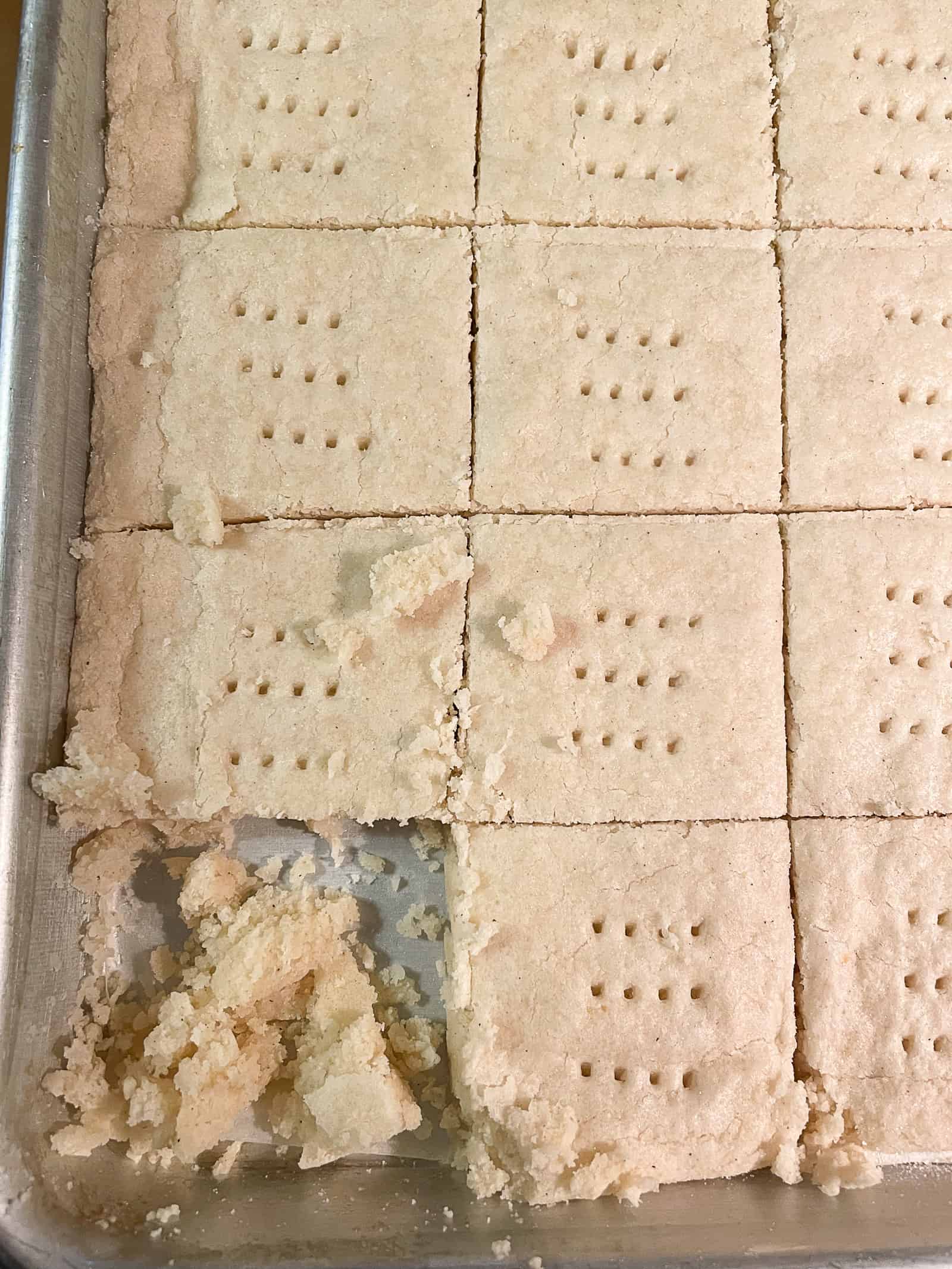
After baking, let the cookies cool in the pan. If you try to move them or cut them right after baking, they’ll crumble.
5. Poke Before Baking.
Whatever method you use to shape the cookies, it’s important to poke the tops gently with a fork. These tiny holes help the steam to escape during baking and keep the cookies from bubbling. To do this, press a fork gently into the tops of each cookie. There’s no need to press all the way through the dough. This might crack it. Instead, press the fork about halfway through the dough.
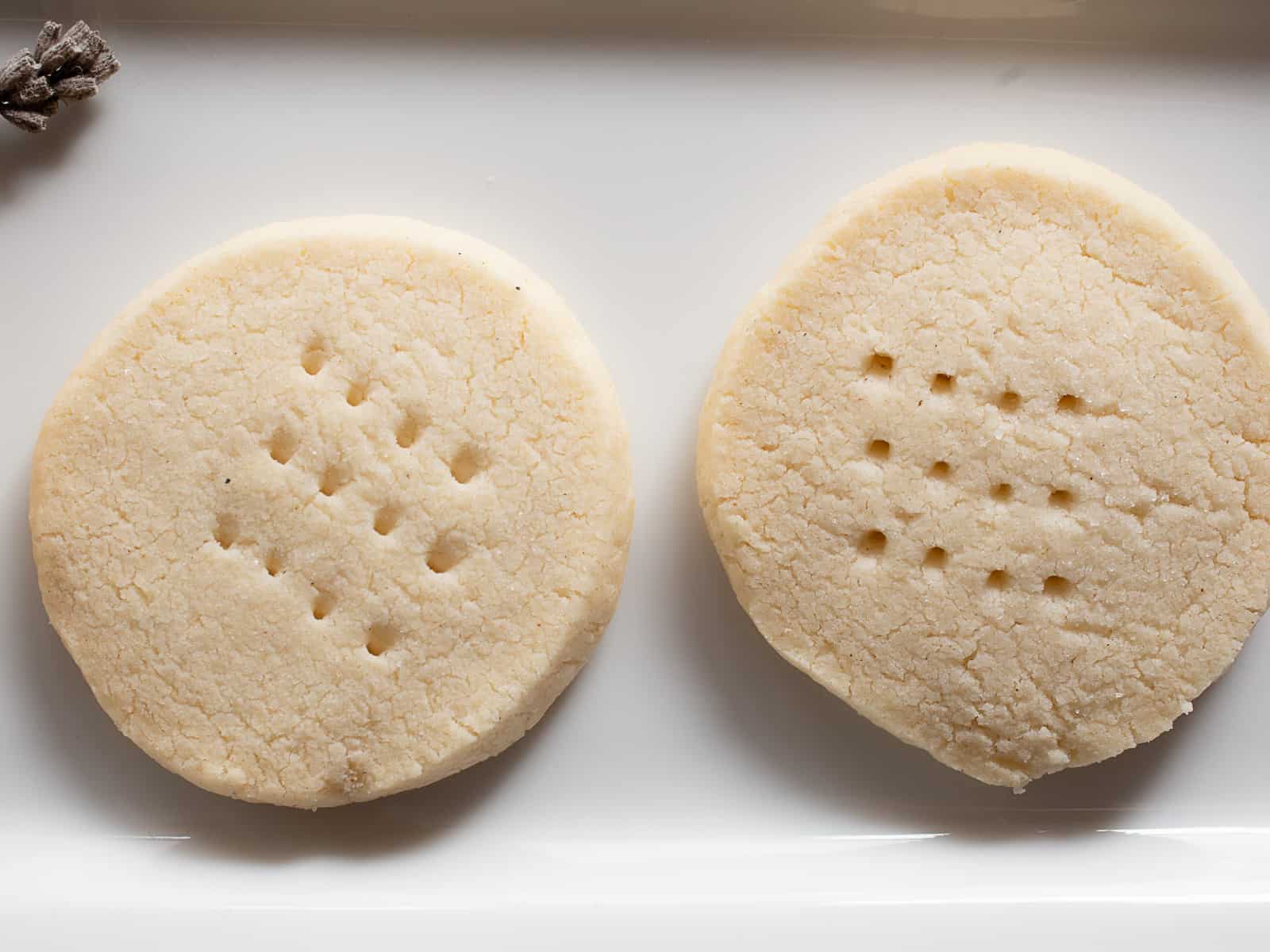
6. Bake Until Set
Shortbread cookies are baked at a lower temperature than most cookies. This low temperature keeps the cookies pale in color and gives them that delicate texture.
So how do you know when the cookies are done? Look for the edges to be a very light brown. The cookies should look set. If they seem shiny or appear dough-like, bake them a little longer. Small hairline cracks often appear on the surface of gluten-free shortbread cookies. This is normal and nothing to worry about.
7. Cool.
Cooling is an important step for these cookies. Since they’re so buttery, they can crumble when warm. If you make individual cookies, transfer them to a wire rack to cool. If you bake your shortbread in a pan, cool them in the pan for at least 30 minutes and then remove them.
Variations.
- Gluten-Free Lemon Shortbread. Add the zest of one lemon and one teaspoon of lemon extract to the dough.
- Gluten-Free Chocolate Chip Shortbread. Replace the granulated sugar with half granulated sugar and half light brown sugar. Add 6 ounces, about one cup, of chocolate chips or chopped dark chocolate.
- Gluten-Free and Dairy-Free Shortbread. For a gluten-free and dairy-free shortbread, replace the butter with your favorite dairy-free butter for baking. If the dough seems too soft, add a tablespoon or so of additional gluten-free flour and chill the dough for 30 minutes before baking.
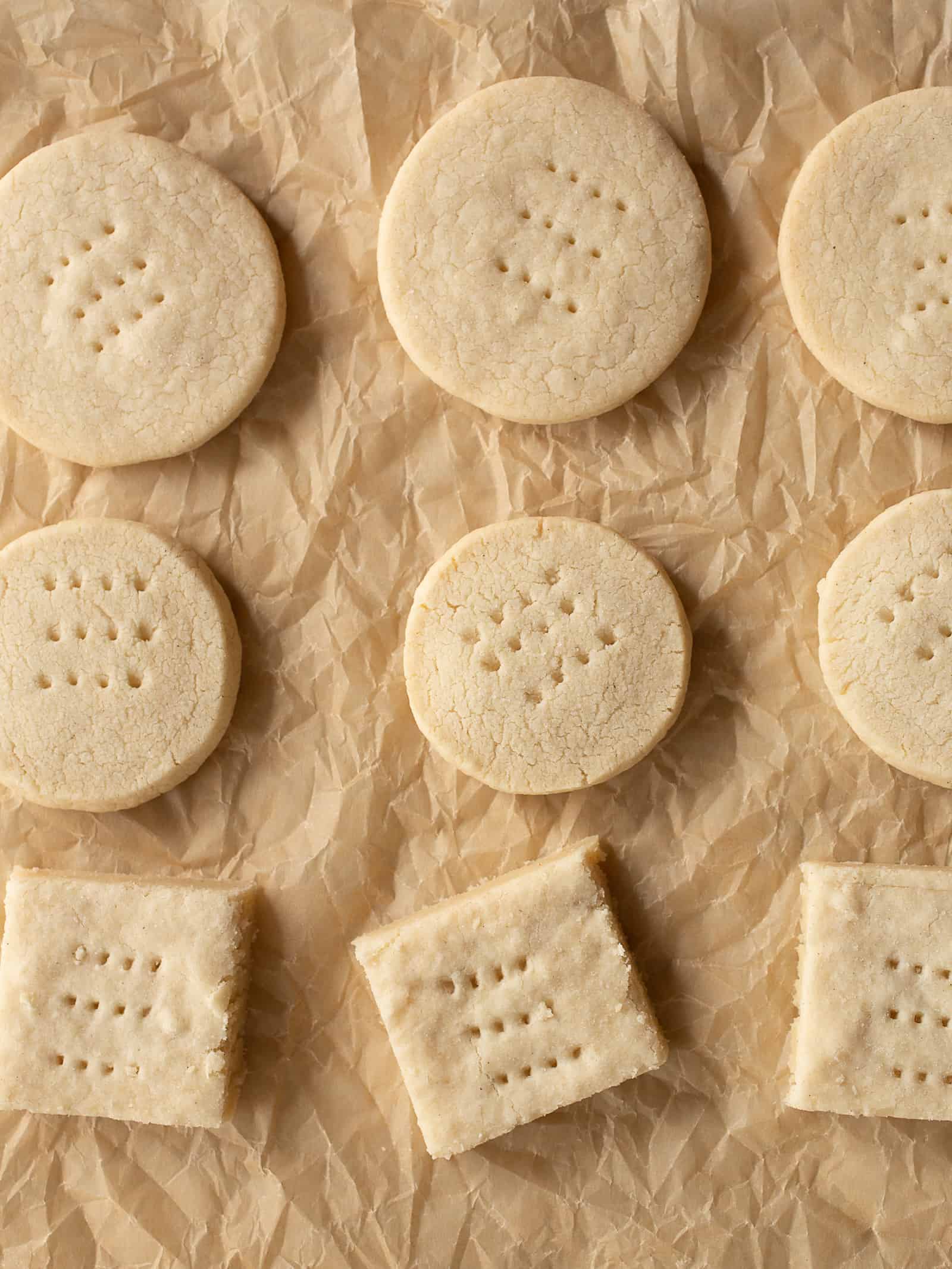
How to Store Gluten-Free Shortbread
Gluten-free shortbread dough and cookies are good “keepers.” Here’s how to make them in advance and store them.
How to Store Shortbread Dough.
You can make the dough ahead and store it, tightly wrapped in plastic wrap, for up to one week in the refrigerator, or 2 months in the freezer.
Gluten-free shortbread dough gets very hard when stored in the refrigerator. Let it come to almost room temperature before rolling or it will crack. You can cut the cookies into rounds before storing them. If you do, remove the cookies from the refrigerator, place them on a parchment-lined baking sheet and bake them in a preheated oven.
How to Store Baked Gluten-Free Shortbread Cookies.
To store at room temperature: Place the cooled cookies in an airtight container. They keep at room temperature for up to 5 days.
To freeze the cookies: place them into a freezer container. You can separate layers with a piece of parchment or waxed paper. Freeze the cookies for up to two months.
To thaw the frozen dough or cookies: place on the counter for several hours.
Solving Common Gluten-Free Shortbread Problems.
My cookie dough isn’t coming together, what do I do?
- Give it a squeeze. If your dough looks crumbly but easily holds together when squeezed, press it into ball with your hands or a sturdy spatula. Some mixers aren’t strong enough
- Check the temperature. Cold gluten-free shortbread doesn’t come together easily. If your dough feels cold to the touch, let it warm for about 20 minutes and then try mixing again.
- Add a tiny bit of water. If you’ve checked numbers one and two and the dough still won’t come together, stop your mixer and add two teaspoons of water. This should help it come together.
Note: If after checking the butter temperature and adding water, the dough still won’t come together, I’d check how much flour you added. If you accidentally added too much, the cookie dough will remain too dry.
The shortbread dough is very soft and hard to roll/shape.
If your dough is sticky and hard to roll, feel it. If the dough feels warm or at room temperature, cover it and chill it in the refrigerator for 30 minutes. If the dough feels cool, add a tablespoon of additional gluten-free flour.
The dough is firm and hard to roll.
If your dough is cracking and hard to roll, cover it and let sit for 20 minutes. It might be too cold. If that doesn’t fix the problem, add a teaspoon of water and mix until a dough forms.
The Cookies Spread.
These shortbread cookies should hold their shape during baking. If they spread into thin cookies, a few things could have happened.
- The butter might have been too warm. If you make the dough with very soft butter or the dough warms up (gets squishy) before baking, the cookies can spread.
Next time, keep the butter at room temperature. If the dough gets warm before baking, chill it for about 15 to 20 minutes before baking the cookies.
- Too much liquid was added. More than about two teaspoons of liquid can cause the cookies to spread.
- The gluten-free flour. Each brand of gluten-free flour bakes differently. I tested this recipe with Bob’s Red Mill 1:1 Gluten-Free Baking Flour. Be sure your blend contains xanthan or guar gum. This is key to helping the cookies hold their shape.
- Measuring mistake. It happens to even the best baker: a measuring error. If the cookies didn’t have enough flour or contained too much butter, they will spread.
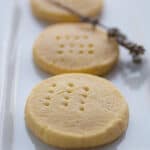
Gluten-Free Shortbread
This gluten-free shortbread recipe makes cookies that are rich and flavorful. The texture is wonderful: slightly crumbly in the best way. The cookies are egg-free and can be made dairy-free.
Ingredients
- 1 cup butter, softened (about 68℉) (2 sticks; 8 ounces; 198 grams)
- 1 teaspoon salt
- ¾ cup granulated sugar (5 ¼ ounces; 148 grams)
- 1 teaspoon vanilla extract
- 2 ½ cups gluten-free flour blend, see note (12 ounces; 345 grams)
Instructions
-
Preheat oven to 325°F.
-
Combine softened butter, granulated sugar, and salt in the bowl of a stand mixer or in a large mixing bowl.
Mix until thick and creamy, about one minute. Use high speed with a handheld mixer and medium-high speed on a stand mixer.
Stop the mixer and scrape the bottom and sides of the bowl. Add the vanilla extract. Mix for an additional minute. Add the gluten-free flour.
-
Stand Mixer directions: mix for about two minutes on medium-high speed. Be sure to use the flat paddle attachment.
Stand mixer directions: Mix on high speed. If the dough seems crumbly after two minutes, stop the mixer. Squeeze the crumbs. If they hold together, press the dough into a ball with your hands or a sturdy rubber spatula. If the dough does not hold together when squeezed, see note below.
-
Shape the Dough.
For slice and bake cookies: divide the dough in half. Dust your counter with gluten-free flour. Knead the. dough a few times until smooth. Then roll out into a log, about 2 inches in diameter. Use a sharp knife and cut into rounds, about ½-inch thick. Place the cookies onto a parchment-lined baking sheet, about 1 inch apart.
For cut-out cookies: Lightly white rice flour your countertop. Turn dough out onto counter and shape dough into a disk. Using a rolling pin, roll dough out, about ½-inch thick.
Cut into shapes. Dip your cutter into gluten-free flour to keep the dough from sticking to the cutter. Place the cookies onto a parchment-lined baking sheet, about 1 inch apart. Gently knead leftover dough into a ball and re-roll. If the dough gets warm, chill it for about 20 minutes.
For a pan of cookies: Lightly grease one 9×13-inch pan or two 8-inch round pans. Line with parchment paper. Press dough evenly into the pan. Score into 24 cookies for the 9×13-inch pan and cookies and about 8 triangles each for the 8-inch round pans.
-
Poke small holes into the tops of each cookie. Do this for the slice and bake, cutouts, and pan of cookies. You want about three rows of holes per cookie.
Bake until the cookies are set, about 35 minutes. Look for the edges to be lightly golden brown.
Transfer individual cookies to a wire rack. For a pan of cookies, allow the cookies to cool right in the pan.
-
Store cookies in an airtight container for up to one week. Or freeze the cooled cookies for up to two months in a freezer container.
Recipe Notes
Gluten-Free Flour.
Use a gluten-free flour blend that contains xanthan gum. If your blend doesn’t contain xanthan gum, whisk ¼ teaspoon into the flour before using.
How to Fix Crumbly Dough.
If your dough is crumbly and isn’t coming together, here’s how to fix it:
- Give it a squeeze. If your dough looks crumbly but easily holds together when squeezed, press it into ball with your hands or a sturdy spatula. Some mixers aren’t strong enough
- Check the temperature. Cold gluten-free shortbread doesn’t come together easily. If your dough feels cold to the touch, let it warm for about 20 minutes and then try mixing again.
- Add a tiny bit of water. If you’ve checked numbers one and two and the dough still wont’ come together, stop your mixer and add two teaspoons of water. This should help it come together.
Note: If after checking the butter temperature and adding water, the dough still won’t come together, I’d check how much flour you added. If you accidentally added too much, the cookie dough will remain too dry.


Kate says
The recipe just says butter. Is the assumption that butter is salted, unless specifically noted otherwise?
Thank you, I am so looking forward to making these this weekend!
Elizabeth says
For shortbread cookies, I use salted butter. The recipe tastes great with either salted or unsalted butter. Use whichever you love (and have in the fridge!). 🙂
Shannon says
I’m currently making this, and I measured out everything precisely on a scale. It’s not forming a dough. Do you have any suggestions? Thanks
Elizabeth says
Keep mixing! It sounds like the butter might have been a wee bit cold. If it doesn’t form a dough after that, add a little (1 teaspoon to 1 tablespoon) water and mix!
K says
Adding even a little water will change the texture of shortbread. Add vodka, one teaspoon at a time. The vodka will bake off and not change the texture or the taste of the shortbread.
Elizabeth says
That’s true for wheat-based baking but isn’t true for gluten-free baking. Due to the varying amount of hydration in gluten-free flours, a small amount of additional water benefits these cookies in a way that vodka would not.
Brian says
The same is true of high altitude adjustment (above say 5000 feet). A slight bit of additional water (1Tsp) and a little less sugar are common adjustments.
Alison says
Thanks for the recipe. I also really appreciate all the tips you included, as well!
Elizabeth says
You’re welcome!
Georgie says
‘Dairy free shortbread is a skip’. How insulting to people who have allergies and no choice but to be dairy free. Might as well just skip dairy free people too.
Elizabeth says
Did you read my entire comment? My goal, as always, is to communicate to readers what to expect from the recipe I’ve provided. I don’t want to waste your time or ingredients. If I were dairy-free, I’d skip *this recipe*. I then go on to tell folks what to expect if they decide to make this recipe without dairy.
I wrote an entire cookbook that doesn’t use dairy. Plus you can find LOTS of dairy-free recipes on this site.
Here’s my comment about why I think *this recipe* doesn’t really work when made dairy-free.
GLUTEN-FREE SHORTBREAD RULE #4
USE BUTTER (OPTIONAL, SORTA)
In my opinion, dairy-free shortbread is a skip. Butter is an essential ingredient in these cookies. Made with a dairy-free fat, I don’t think shortbread cookies are worth the time or the calories. Without butter, shortbreads main flavor, they just taste kind of flat. However, if you like the taste and texture of coconut oil or a different dairy-free fat, go ahead and give it a try. When selecting a dairy-free fat, be sure to use a solid fat, not a liquid oil.
MommaOfMayhem says
Have you tried any other flour (coconut or almond)? My 8 year can’t have rice, amaranth, barley, or wheat. Every other recipe we have tried is less than impressive. Blessings!
Elizabeth says
I haven’t made this recipe without grains and since grain-free flours behave so differently than grain-based flours, it’s not an easy swap.
That said, I have three grain-free cookie recipes on the site and lots in my Paleo Baking book.
Here are three to get you started:
Grain-Free Chocolate Chip Cookies
Grain-Free Roll Out Cookies
The Easiest Cookies EVER. 🙂
Oh, and just for fun, here’s a grain-free brownie recipe.
MommaOfMayhem says
Thank you so much. Being 8 and starting a new food regime has had its share of bumps. I’m sure these will help!
Samantha says
I just read somewhere else that arrowroot is often used in a shortbread-like cookie…so that might work.
Carol says
Ground nuts make amazing cookies. You can use almonds, walnuts, pecans, hazelnuts, cashews or any combination. You may need to use less butter because the buts are full of oil. Use at least 1/3 parts cornstarch or arrow root flour. You can try part cocoanut flour. Cooking time may shift slightly. I love them browned a bit so the nuts toast. A food processor makes all this easy. Frozen butter works fine. Nuts get ground up in mixing. East. Xanthan gum probably a good idea though I don’t generally use it.
MommaOfMayhem says
Let me clarify. The other recipes we have tried are from friends or family members. I have not tried any of your recipes.
Elizabeth says
🙂
Ruth says
Can you tell me if there is another name for sweet rice? Can’t find it in UK. I made my Own white rice flour now need to find sweet rice to make that flour
Elizabeth says
Sweet rice is also known as “sticky rice”, “short grain rice”, glutinous rice”, “waxy rice”, and “pearl rice.” I hope this helps!
Autumn says
Mochi at an Asian food store:)
Olivia says
I made this with half rice flower and half hazelnut flower and it turn out awesome, the dough was like a play dough, very easy to manage. But 1 thing I wanted to add, I used 3 times less sugar and they still turned out just a bit too sweet to my taste. I think there’s way too much sugar in this recipe. But overall, very nice recipe, I was pleasantly surprised. Delicious cookies
Elizabeth says
Swapping a nut flour for grain-based flours will always affect flavor and sweetness. I’m glad you enjoyed the recipe!
Z. says
Hi, I would like to attempt these cookies, but the only thing I don’t have is the sweet rice flour. I do have brown rice flour, almond flour, coconut flour, tapioca flour, potato starch and arrowroot. Can I use any of these to sub for the sweet rice flour? And if so, how much? Thank you.
Elizabeth says
Brown rice flour works as a good substitute. The other flours would not work as a sweet rice flour replacement. Hope this helps!
Deborah says
Love this recipe so easy to make and my son (coeliac) loved them. We all did. Thanks very much.
Elizabeth says
Glad you enjoyed it!
Cate says
Delicious cookie! I used cultured butter and lemon infused sugar. Cookies are buttery, crisp, and just sweet enough. Perfect tea cookie. I think this is going to be my favorite gluten free cookie.
Can you freeze this dough? If so, should it be frozen in a log, or is it better to freeze cut out cookies?
Elizabeth says
Yes! This dough can be frozen. Just be sure to wrap it tightly in plastic wrap and then again in foil. You can keep it in the freezer for up to six weeks.
Lisa says
Can I use this for a pie crust? If yes should I blind bake first? I need a wheat free pie crust for my granddaughter with Celiac. Thank you!
Elizabeth says
I wouldn’t use this one for pie crust. Here’s my pie crust recipe. Enjoy!
https://glutenfreebaking.com/how-to-make-gluten-free-pie-crust/
Becauseiambatman says
What can you swap corn starch for?
Elizabeth says
Potato starch or tapioca starch would work great!
Jan says
These are the best gluten free biscuits ever! Really delicious. I am using products sourced in New Zealand. I used white rice flour throughout and added an extra ounce of butter.
Rita says
I am hopeless at gluten free baking Daughter brother sister and close cousin all ceoliacs. Every time I try it never turns out right. Thankfully my daughter is a great cook Will try this recipe. Thank you
Wendy says
I just tried this and they don’t look anything like your picture. They really spread out and look more like you picture of the sugar cookie. Any suggestions? I used the measurements by weight.
Elizabeth says
Hmm…my first guess is that the dough was a little warm. Perhaps chill the dough before baking the next time.
Did you have to make any ingredient substitutions?
Kellie says
Will this cook in a silicone mold for a shortbread house.
Elizabeth says
I think so! The baking time will differ depending on the size of the mold. Have fun!
Gayla says
Elizabeth, thank you so much for this recipe!! I’m no longer sad that I can’t buy Walker Shortbread. 🙂 I did use tapioca starch instead of cornstarch, and it the cookies were fine. Also, after mixing w/ a hand held electric mixer for 2-3 minutes, I remembered a friend who always mixes her shortbread dough by hand. So I finished mixing the dough by hand, and it only took about 60 seconds until the dough came together. I followed your instructions to refrigerate the cookies before baking. Success! Thank you.
Elizabeth says
Yay! Yes! Sometimes shortbread dough does NOT want to come together. Glad your remembered your friend’s trick. It’s a good one.
Enjoy the cookies.
LeNoir says
Hi! These look great. I am making them with lavender added and using honey instead of sugar (an idea from another recipe). Can I just use a pre-made gluten free mix instead of buying all the ingredients separately? Have you ever tried that?
Elizabeth says
The gluten-free flour should work in the recipe. However, I’m not sure about using honey. A liquid sugar works very differently from a dry sugar. They might spread a lot if you make them with honey.
Violet says
Hi there – I’ve made these several times with no substitutions (except using tapioca starch instead of corn) and every time I make them, they spread out A LOT. I have tried freezing them until solid, being really careful about beating less air into the butter/sugar, and adjusting the oven temp to be lower (and yes used a thermometer), but they come out flat every time! Disappointed because I love all your recipes and this is the only one I have trouble with. Really not sure what’s going on. they taste amazing though!
Elizabeth says
May I ask what brand of flour you’re using and if you’re measuring by weight or volume? Let me know and we can get to the bottom of this. 🙂
Violet says
Thanks for the reply! I use bob’ red mill for tapioca and sweet rice, but for the white rice flour I use authentic foods superfine. I always measure with weight (because I bake A LOT). My workaround: I reduced the amount of butter, took out the baking powder, and used about 2 tbsp of water (to make the dough come together).
Susannah says
At what point do you make the fork prints in the cookies?
Elizabeth says
Right before baking. I’ll add a note!